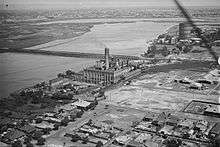East Perth Power Station

The East Perth Power Station is a disused power station located in East Perth, Western Australia.The site consists of a complex of industrial buildings occupying more than 8.5 hectares, bounded by East Parade, Summers Street, the Swan River and the Graham Farmer Freeway.
History
The Power Station was constructed between 1913 and 1916 by the Western Australian State Government, which announced that the facility would generate all the electricity needed in the Perth Metropolitan area. The site of East Perth was chosen because coal could easily be delivered there by rail and because the enormous quantities of cooling water required by the condensing plant could easily be drawn from the Swan River. Construction was completed at a total cost of £538,000.[1]
In the 1920s, 1930s and 1950s new power generators were added to the facility to meet the city's growing demand for power. By 1948 the station had an array of power generating sources.[2]
In 1968 the station converted from coal to oil, but six years later returned to coal firing. The station was decommissioned and closed in December 1981, as more advanced and cheaper methods of electricity generation made the facility redundant.[1]
The East Perth Power Station is considered to be one of the State's most significant industrial heritage buildings.[3] It includes a range of remnant machinery and equipment that is believed to be unique in the world because it contains the five different stages of power generation technology that occurred in the 20th century.[4][5]

Conservation and protection
As early as 1993 plans were in place for conservation and protection of the site.[6][7][8]
Proposed redevelopment
In the 2000s the East Perth Redevelopment Authority developed a draft master plan[4] for the site's future use, which went out to the public during a three-month community consultation period (7 November 2004 – 28 February 2005). Site works commenced in July 2004 and included a general clean up, building stabilisation and weather proofing.[3]
In early 2005 the Government of Western Australia appointed a Major Stadia Taskforce to report on the construction of a new stadium in Perth. Its final report recommended the construction of a new 60,000 seat stadium at either Kitchener Park (which adjoins Subiaco Oval) or at the East Perth Power Station site. In early 2008 the Government confirmed that Subiaco Oval would be demolished for the new Perth super-stadium to be built next door at Kitchener Park.[9] This site was chosen ahead of the other suggested site at the Power Station, which was instead to house a new $500 million museum.[10] Planning and design of the new museum was to begin in 2008, with construction expected to begin in 2012. The extensive fit-out required for the museum was scheduled to start in 2013, with completion of the entire project expected in late 2015.[11]
The redevelopment was to have been overseen by the Government's Office of Strategic Projects.[10]
In 2007 an oral history project was conducted of former workers at the site - and the recordings are held at Battye Library.[12]
Following the election of a new State Liberal party government under Colin Barnett, the redevelopment plans were scrapped in early February 2009 as part of a response to reduce government expenditure.[13]
In 2011, University of Western Australia historian, Charles Fox published a history of the station Powering Perth.[14]
In February 2015, the site was subdivided into four lots for sale to developers. The first lot offered for sale includes the power station building, which the purchaser would be required to preserve and redevelop.[15]
References
- 1 2 East Perth Redevelopment Authority, Fact Sheet
- ↑ p.261 of Tait's electrical Directory of Australia and New Zealand, 12th Edition, 1948, Tait Publishing, Melbourne, Vic.: 3 International Combustion boilers, 10 Babcock & Wilcox marine-type boilers; as well as Green's economisers and Parson's turbo-alternators
- 1 2 East Perth Redevelopment Authority, East Perth Power Station
- 1 2 Draft Master Plan (PDF), 2004, retrieved 2016-06-20
- ↑ Archer, J. C. A brief history of the development of East Perth Power Station. 1982. "Prepared under the auspices of the Engineering Heritage Sub-Committee of the Institution of Engineers, Australia - Western Australia Division".
- ↑ Bodycoat, Ronald.(1993) East Perth Power Station [cartographic material] : conservation plan : prepared for the East Perth Redevelopment Authority / Ronald Bodycoat, Oline Richards. East Perth, W.A. : distributed by the Heritage Council of W.A.
- ↑ Tweedie, Lindsay. East Perth Power Station conservation plan : prepared for the East Perth Redevelopment Authority and State Energy Council of Western Australia. Volume 3. Detailed inventory of plant and equipment Perth, W.A : distributed by Heritage Council of W.A.
- ↑ Godden, Don. East Perth Power Station heritage significance assessment : report prepared for the State Energy Commission of Western Australia. Perth, W.A. The Commission, 1992.
- ↑ Perth to get new $1.1 billion stadium The Age 8 February 2008
- 1 2 Government of Western Australia, Media Release: 'New major sports stadium for Western Australia', 8 February 2008
- ↑ Government of Western Australia, Media Release: 'Western Australia to build a Museum for the 21st century', 8 February 2008
- ↑ http://henrietta.liswa.wa.gov.au/search~S2?/tEast+Perth+Power+Station+historical+research+proj/teast+perth+power+station+historical+research+project/-3%2C-1%2C0%2CB/exact&FF=teast+perth+power+station+historical+research+project&1%2C109%2C
- ↑ Sports stadium and museum plans scrapped Australian Broadcasting Corporation 2 February 2009
- ↑ https://www.socrates.uwa.edu.au/Pub/PubDetailView.aspx?PublicationID=468990
- ↑ Andrew O'Connor (20 February 2015). "Historic East Perth power station site offered to developers for waterfront residential, commercial and arts precinct". Australian Broadcasting Corporation. Retrieved 21 February 2015.
Coordinates: 31°56′46″S 115°52′50″E / 31.94624°S 115.88047°E